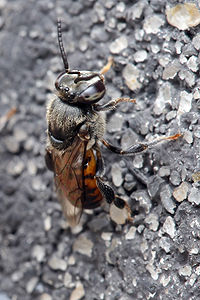
Photo from wikipedia
Task allocation is a central challenge of collective behavior in a variety of group-living species, and this is particularly the case for the allocation of social insect workers for group… Click to show full abstract
Task allocation is a central challenge of collective behavior in a variety of group-living species, and this is particularly the case for the allocation of social insect workers for group defense. In social insects, both benefits and considerable costs are associated with the production of specialized soldiers. We asked whether colonies mitigate costs of production of specialized soldiers by simultaneously employing behavioral flexibility in nonspecialist workers that can augment defense capabilities at short time scales. We studied colonies of the stingless bee Tetragonisca angustula, a species that has 2 discrete nest-guarding tasks typically performed by majors: hovering guarding and standing guarding. Majors showed age polyethism across nest-guarding tasks, first hovering and then changing to the task of standing guarding after 1 week. Colonies were also able to reassign minors to guarding tasks when majors were experimentally removed. Replacement guards persisted in nest defense tasks until colonies produced enough majors to return to their initial state. Tetragonisca angustula colonies thus employed a coordinated set of specialization strategies in nest defense: morphologically specialized soldiers, age polyethism among soldiers within specific guarding tasks, and rapid flexible reallocation of nonspecialists to guarding during soldier loss. This mixed strategy achieves the benefits of a highly specialized defensive force while maintaining the potential for rapid reinforcement when soldiers are lost or colonies face unexpectedly intense attack.
Journal Title: Behavioral Ecology
Year Published: 2019
Link to full text (if available)
Share on Social Media: Sign Up to like & get
recommendations!